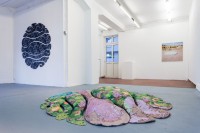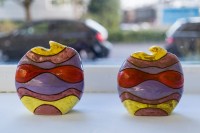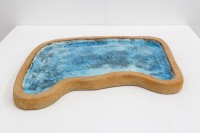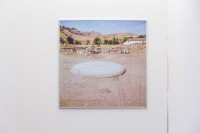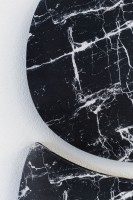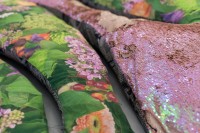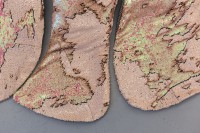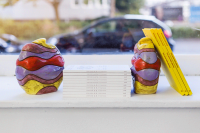The Belly
of the
Phoenix
11 June – 12 August 2017
Last Tango, Zurich
| Curated by | Arianna Gellini and Linda Jensen |
| In collaboration with | Nicola Genovese and Laura Locher |
| All photos by | Kilian Bannwart |
| Text edited by | Isabel Löfgren |
For this new body of artworks, Bernardi pays homage to Lebanese artist Saloua Raouda Choucair (1916–2016) and her so-called “mini forms,” a series of stratified small sculptures, abstract and refined, very symbolic of this female artist often defined as a modernist pioneer in the Middle East. Originally conceived by the artist as sketches announcing greater realizations, this series of works had to remain small due to lack of means, yet filled with potential and waiting for an opportunity to materialize. In that sense, Bernardi’s custom-made shaped canvas, textiles and hand-made ceramic objects inflect both monumental and miniature scales as the forms are enlarged to the size of the Roman Bocca della Verità (1.7m in diameter) down to only a few centimeters wide. With sinuous horizontal and cascading lines and different materials, Der Bauch des Phönix (The Belly of the Phoenix) encodes lineage, rupture, sagging and synchronicity.
The title of the exhibition, The Belly of the Phoenix indicates a cycle of regeneration where stacking and accumulation take over any cyclical or spiral dynamic. The series of works are concretized using canvas, fabric or ceramic, and play with the notion of sedimentation, layering, aging, wrinkling as well as acquiring new curves and fluctuations, not only as an allusion to time but also to movement and displacement. Like the famous Michelin figure, whose anatomy is made of tires, physically indicative of the many journeys traveled, regeneration here is embodied as a figure in constant transformation instead of a birth coming from the ashes of a lost body, as is the case of the phoenix.
When a woman turns forty, she begins to get noticed for qualities other than her physique. Something else defines this aging feminine subject in order to be considered, looked at or even esteemed in normative Western society. “Cougar” is a term used for more mature women who are nevertheless still “in the game” and is sadly sometimes used to discriminate against older women. However, the fleshiness of her body must, like art and life remain living for at least another forty years ahead. Is the aging body some kind of rebirth? Different materials are used in the artworks to embody such a narrative that deals with machismo and discrimination against age, but not only—The Belly of the Phoenix is after all about having a good laugh.
Imagine for a moment that the phoenix hasn’t yet caught on fire, but simply put on some weight. And what about its waist size or its belly, is it a uterus, the stomach or even the long and folded chain of the intestines, where everything gets processed, sorted out, assimilated or leading towards an exit? What does it mean to be in a constant state of digestion and interaction with people and places? What entails a constant mediation between oneself and what stands outside of you, be it one’s identity as an artist, the parent-child relationship or kinship in general, institutional ties and duties, teacher-student or even power relations between superior and subaltern? What kind of negotiation, arrangement and remodeling are made between all these stratifications? Seriality, variation, declination and reutterance of a single drawing, a fragmented disc almost smiling at you with mischievousness, brings many other codes and aspects into play.
Produced in collaboration with the artist Nicola Genovese, Elegant sagging (2017) is a shaped canvas on the wall whose size is the same as the Bocca della Verità in Rome. With clear lines, it delineates the solar constellation of an archipelago made of fake black marble. Genovese is equally involved in the making of Almost Ninja Turtles, I–IV (2017), a series of four multicolored, plump, tubby and shiny bibelots. On the floor, Carpet Pond (2017), is composed and fabricated together with fashion designer Laura Locher. By quilting together different quality of fabrics, such as digitally printed cotton, snake or scale-like sequins or embroidery, a hilly horizontal landscape is created, in a reference to Monet’s late Nymphaeas which can be seen at the Kunsthaus Zürich.
The source of this playful assemblage is made out of historical references just like Choucair’s artworks, but also relies on photographs of the artist’s father which can be seen in Bernardi’s artist book Into Your Solar Plexus (Humboldt Books, 2016), equally available for viewing in the exhibition.
